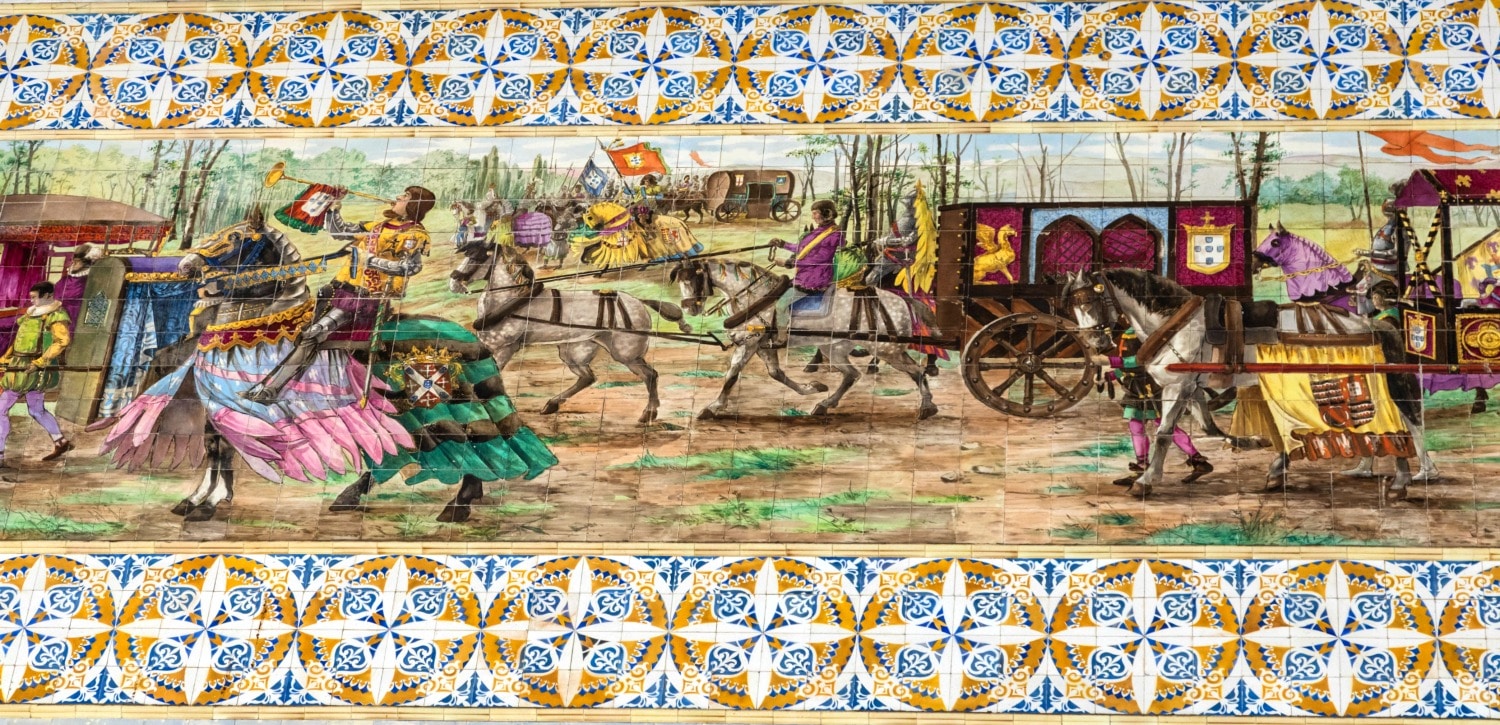Take one step inside, and you can’t help but stand still, as if stopped by an invisible hand. Picturesque multi-colored houses climbing the hills of centuries-old Porto on the banks of the majestic Douro River have been the main attraction for countless visitors through the ages. But no traveler should miss visiting one of the most beautiful railway stations in the world. Porto’s São Bento Railway Station, a symmetrical, three-story granite structure in the historic center, is an excellent example of the Beaux-Arts architectural style. It also harbors an unexpected treasure. Nearly every space of the grand hall is covered by panels of azulejos depicting scenes of Portuguese history and the daily activities of the Portuguese people. To give an idea of the scale, in his masterpiece, the renowned artist Jorge Colaço used some 20,000 tiles, each measuring 15 x 15 cm (5.9 x 5.9 inches).
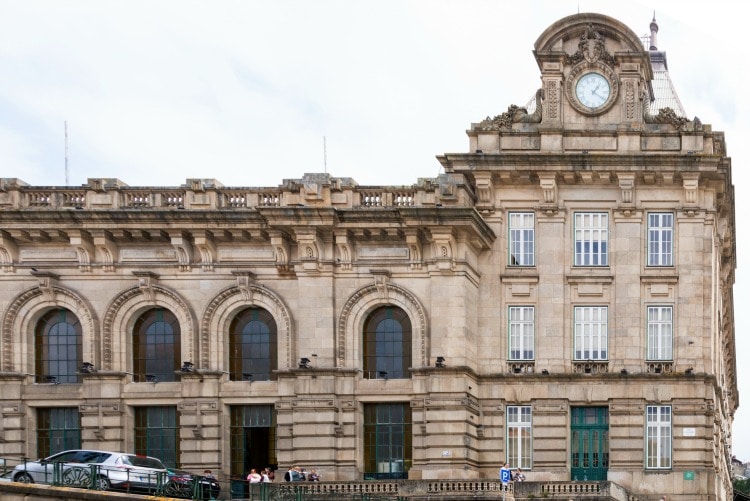
History of the Azulejos
The Moors introduced azulejos – square, painted and glazed ceramic tiles – after their occupation of the Iberian Peninsula in the 8th century. The word ‘azulejo’ is not derived from the Spanish word ‘azul’ (blue, as one might think) but originates from the Arabic ‘al zulaycha’ or ‘az-zulayj,’ meaning polished stone. Impressed by the Alhambra in Granada during his visit to Spain in the early 16th century, the Portuguese King Manuel I decided to have his palace in Sintra decorated with the same tiles. The first ones were imported from Seville, and, true to Islamic law, portrayed no human figures, only geometric patterns.
Azulejos fast became an intrinsic part of Portuguese culture. Nowadays, they are literally everywhere, not only in the traditional blue and white combination but in a myriad of colors and whimsical designs. Azulejos decorate the outside and inside walls of buildings, church façades, fountains, benches, household items, tourism souvenirs, ornaments, even jewelry. A feast for the eyes, the tiles are an art that both educate and inspire and make the ordinary look cheerful and beautiful.
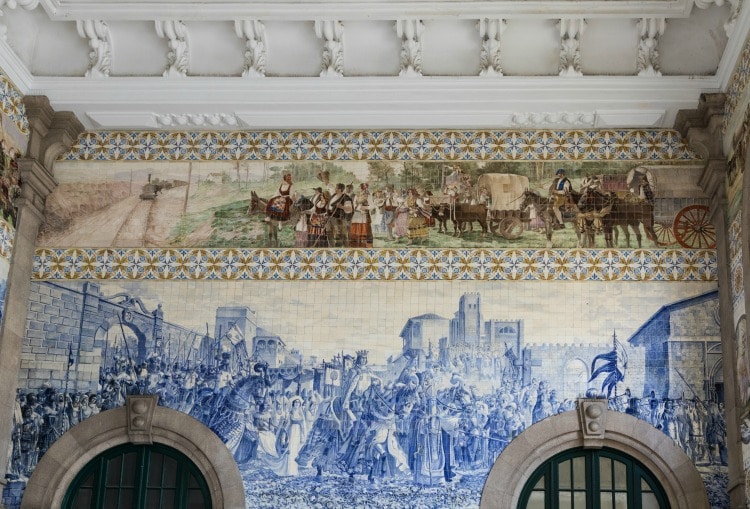
The Station Panels
Exquisitely detailed, the white tiles painted in blue, range from the palest to the darkest tone. Some remarkable ones are:
– Portugal’s King João I and Philippa of Lancaster Arriving in Porto
Trumpet-playing soldiers herald their arrival. Dressed in hand-embroidered royal regalia, they ride side by side on elegant Arabian stallions, adorned with elaborate tack and caparisons. Ladies-in-waiting walk behind them followed by knights on horses bearing flags and lances. People stand close together on tall buildings, trying to get a glimpse of the entourage. Philippa was born in Leicester, England, the eldest child of John of Gaunt, Duke of Lancaster. Her marriage to King João I in 1387 was arranged to cement the Anglo-Portuguese Alliance against France-Castile.
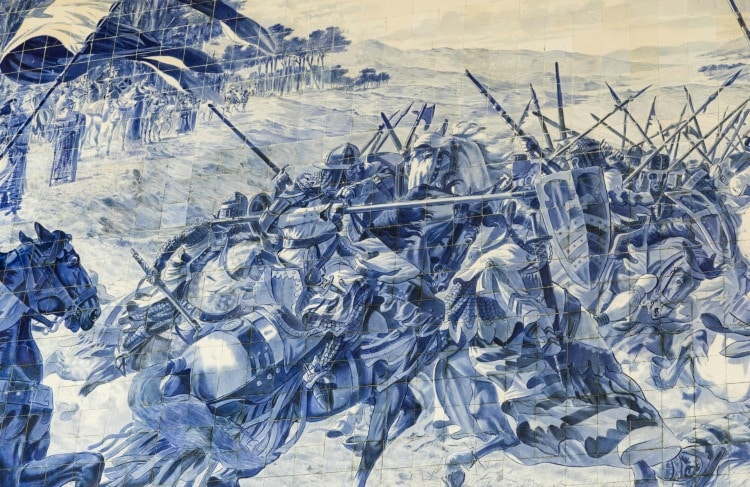
– The Battle of Valdevez at Arcos de Valdevez
This battle between the Kingdom of Leon and the Kingdom of Portugal occurred in the summer of 1140 or 41. Soldiers from both bands clash, spears in the air, their horses’ bulging eyes reflecting their fear.
– The Conquest of Ceuta in 1415
King João I led his sons and the armed forces on an assault of this Moroccan stronghold. A major northern trade center of the Islamic world was now in possession of Portugal.
One panel details a pastoral scene of farmers harvesting and loading hay on carts. Another shows three women crossing a river by boat: one mature and holding an oar scans the horizon with the other two young women sit in front of her, one cradling a baby.
Framed in blue and gold stylized flowers along the top of the hall is a narrow band of tiles in vivid colors showing various battle scenes: a soldier riding a horse draped in green, blue, and pink cloth and blowing a horn is followed by lavishly clad soldiers and horses pulling extravagant wagons. Clearly, theirs was a wealthy commander.
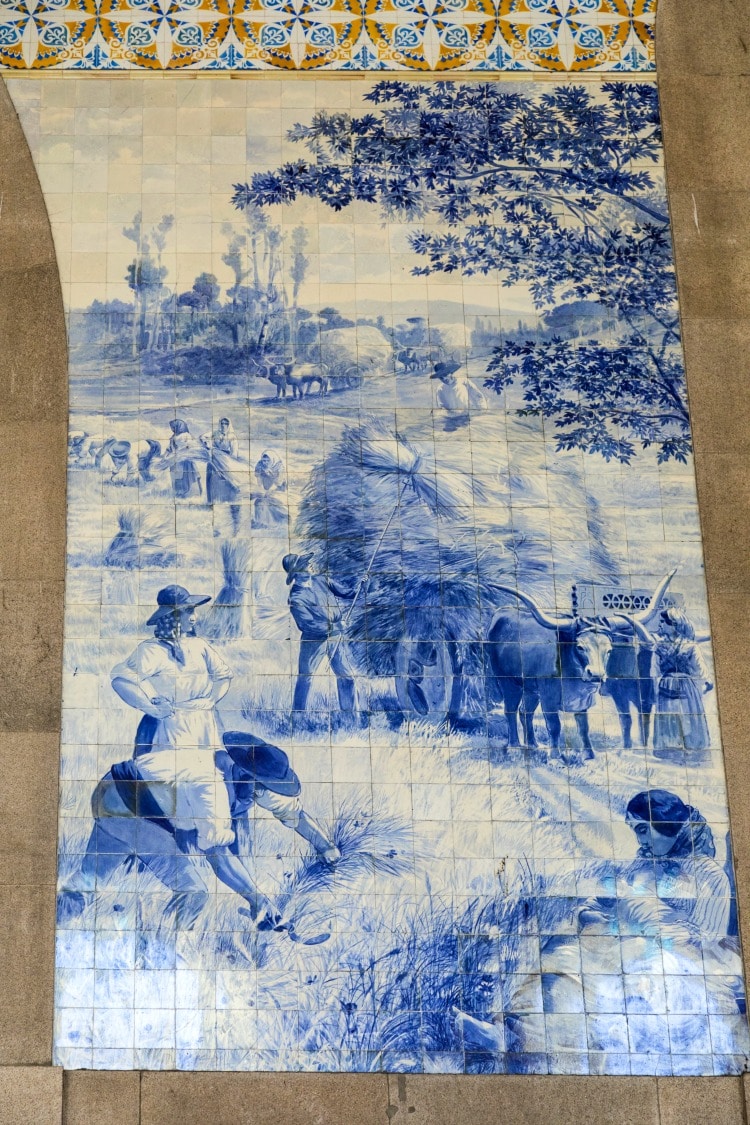
Architect, José Marques da Silva
José Marques da Silva designed the São Bento Railway Station, built on the site of a former convent. A Porto native born in 1869, he initially began his studies there then went to Paris to study at the École Nationale Supérieure des Beaux-Arts. He earned the title of Graduate Architect and returned to Porto in 1896, beginning work on the station in 1900 and completing it in 1916. He was responsible for designing numerous important buildings that changed the shape of the city and left an unforgettable legacy on the architectural landscape. The José Marques da Silva Foundation Institute (FIMS) is dedicated to the preservation of his artistic heritage and is in the architect’s own Residence-Atelier next to the Lopes Martins’ family mansion. It contains the literary, artistic, architectural and town planning collection.
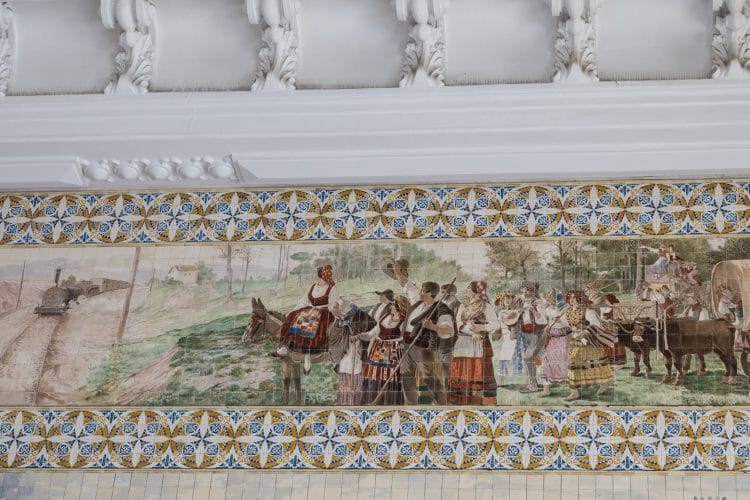
World-renowned Painter Jorge Colaço
Jorge Colaço, son of a Portuguese diplomat, was born in Tangier, Morocco, in 1868. A caricaturist and painter, he became famous for his azulejo paintings decorating large surfaces. He liked to depict significant events of Portuguese history, but also created ethnographic and landscape scenes. The artist introduced several innovations in processes and techniques, especially the method of applying screen printing to tiles. He did this by transferring a painting to fired colorless glaze, and then submitting it to a second firing. Some of Colaço’s dazzling works include the panels covering the façade of Porto’s Santo Ildefonso Church, where some 11,000 azulejo tiles were used. Well-known internationally, some of his works are displayed in Windsor Castle, England, and at the World Trade Organization in Geneva. But certainly no venue was better suited to display his work than the monumental hall of the São Bento Railway Station.
The country code for Portugal is 351.
[alert type=white]
São Bento Railway Station:
Praça Almeida Garrett
+ 351 70 721 0220
Map: www.introducingporto.com/map/sao-bento-railway-station
Where to Stay:
Pestana Vintage Porto – 5-star hotel alongside historic Ribeira Square and a few steps from the Douro River with splendid views of the Dom Luís I Bridge and Vila Nova de Gaia across the river. It’s the perfect location to catch a river cruise or a water taxi. Praça da Ribeira #1, + 351 22 340 2300; www.pestanaporto.com
InterContinental Porto – Set in an 18th-century palace, this 5-star hotel boasts a bar, restaurant and spa. Accommodations range from classic to executive rooms to two-story suites. The hotel overlooks Liberdade Square and is just a few minutes’ walk from São Bento Railway Station. Palacio das Cardosas, Praça da Liberdade # 25, + 351-22-0035600; www.ihg.com/intercontinental/hotels
The PortoBay Hotel Teatro – A 4-star hotel in Porto’s Theater District built on the site of the former Baquet Theatre, which opened in 1859. The PortoBay Hotel’s warm interior colors and spacious rooms convey a refined, bohemian atmosphere. Rua de Sá da Bandeira #84, + 351 22 040 9620; www.portobay.com
Where to Eat:
The Yeatman – Awarded two Michelin Stars in 2017, The Yeatman presents traditional flavors with contemporary flair. It offers a large selection of seafood, fresh produce, and regional specialties. Dinner here is a gastronomic adventure with a panoramic view of the Douro River.
Rua do Choupelo, Vila Nova de Gaia, + 351 22 013 3100; www.the-yeatman-hotel.com
Traça – It’s easy to miss the narrow red door of this outstanding restaurant. Once a drugstore, the building’s original shutters were retained along with some antique furniture and lamps. Their motto is: “Come and travel back in time.” Specialties include delicious game creations like wild boar and venison along with goat, steak, veal and seafood. Largo São Domingos 88, + 351 22 208 1065; www.restaurantetraca.com
Vinhas D´alho – A long narrow dining room with an eclectic menu of seafood, beef, pork, and chicken. On the bank of the Douro River, it’s best in the evening to hear world-famous Fado music.
Muro dos Bacalhoeiros #139/140, + 351 22 201 2874; www.vinhasdalho.com
*There are two iconic dishes served throughout Porto that must be tried:
Francesinha – a complete meal disguised as a sophisticated sandwich: slices of bread stuffed with meat, ham, sausage, and cheese, topped with melted cheese and an egg, and served in a savory tomato-beer sauce. The Portuguese only drink beer with francesinhas.
Pastéis de Nata – a small puff pastry tart filled with a sweet, creamy egg custard flavored with cinnamon and vanilla and baked to a light golden brown.
What to Do:
Port Wine Cellars in Vila Nova de Gaia – A water taxi from Cais de Ribeira by Ribeira Square is the quickest way across the river from Porto. It’s a bit of a steep climb (taxis are an option), but Taylor’s Cellars is worth a visit. After a self-guided tour past rows and rows of barrels in the massive dimly lit cellar, head outside to sample various ports at one of the small tables surrounding a fragrant rose garden. Rua do Choupelo # 250, Vila Nova de Gaia, + 351 223 772 973; www.taylor.pt
Take a 50 Minute Cruise on the Douro River – Sail underneath six bridges, from the double-deck metal arched Dom Luís I Bridge to the Maria Pia Bridge designed by Gustave Eiffel. Enjoy the passing scenery of colorful old Porto, including a view of the Serra do Pilar Monastery with its round church & cloister sitting high above the city. Tickets are available at the tourist booth on Ribeira Square.
Hear Fado Music – Granted it’s not for everyone but spend an evening listening to this traditional melancholic genre. Lyrics tell stories of love and loss, pain and hope, tragedy and happiness. Bring a tissue!
[/alert]

